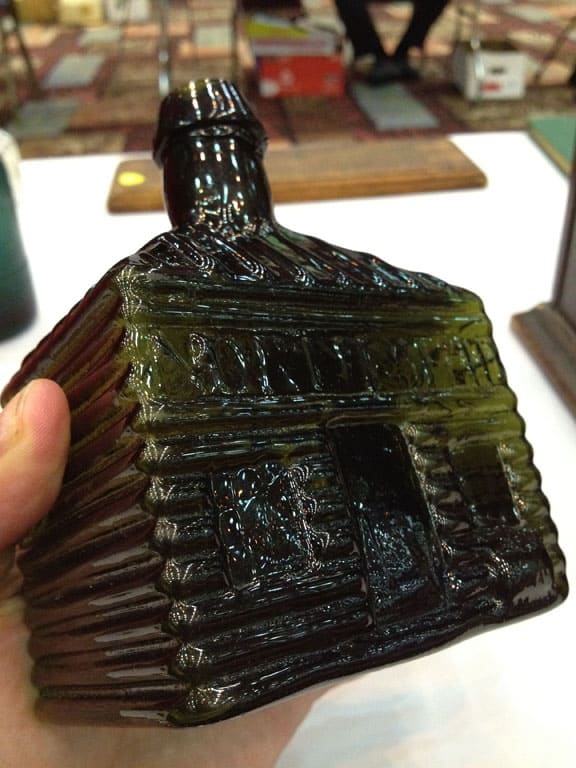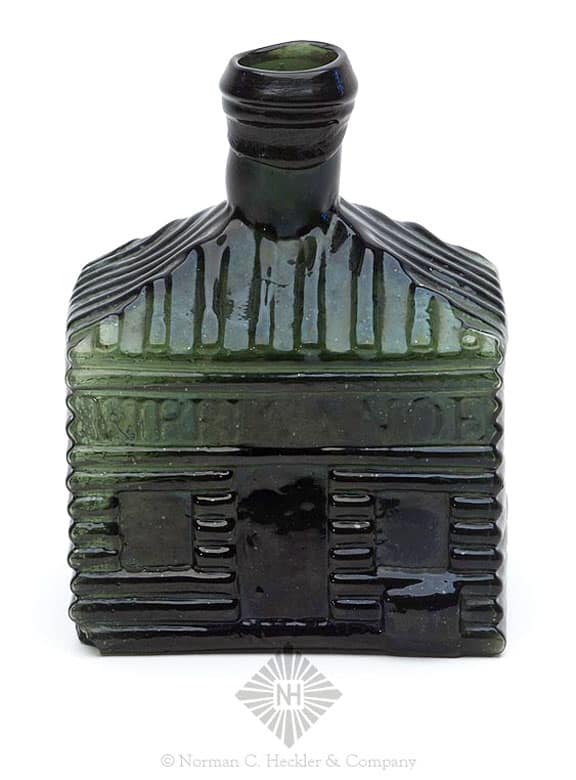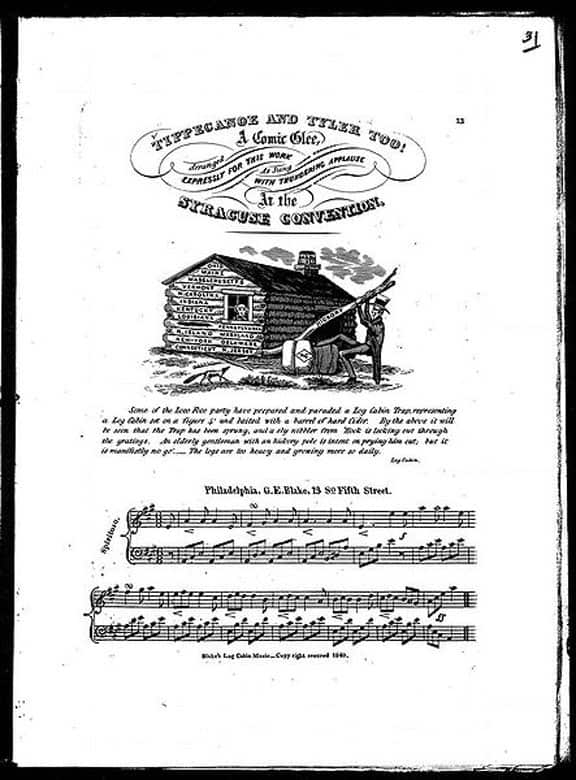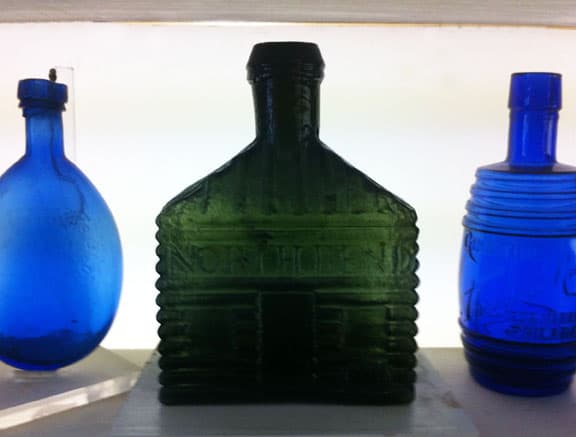“North Bend” – “Tippecanoe” Historical Cabin Bottle in Heckler 100 Auction
15 September 2012 (Updated 110418)
“Tippecanoe and Tyler Too”
![]() Norman C. Heckler probably has one of the most exciting auctions to come along in some time with The Warren C. Lane, Jr., Esquire Collection of Historical Flasks and 19th Century Art Glass featuring the Dr. Gary and Arlette Johnson Collection. The auction is now available for viewing on their website. Bidding will begin on Sunday, October 7, 2012 at 9 AM. To view the auction, please visit Heckler Auction 100.
Norman C. Heckler probably has one of the most exciting auctions to come along in some time with The Warren C. Lane, Jr., Esquire Collection of Historical Flasks and 19th Century Art Glass featuring the Dr. Gary and Arlette Johnson Collection. The auction is now available for viewing on their website. Bidding will begin on Sunday, October 7, 2012 at 9 AM. To view the auction, please visit Heckler Auction 100.
While looking at the many items of great interest and historical significance, I noticed Lot 44 which is the North Bend Tippecanoe Historical Cabin Bottle. I suspect I will be able to see this piece during the 13th Annual Heckler Columbus Day Weekend Event on Saturday, 06 October 2012. The Heckler description of the cabin is written up as follows:
Lot: 44 “North Bend” – “Tippecanoe” Historical Cabin Bottle, probably Mount Vernon Glass Works, Vernon, New York, circa 1840. Log cabin form, deep emerald green, applied sloping collared mouth with ring – tubular pontil scar, ht. 5 inches; (3/16 inch hole in the lower left base corner of the “Tippecanoe” side). GVII-1 Extremely rare, handsome, and a beautiful color. Of the few examples known, most have some damage with the corner hole being the predominant damage noted. Often associated with a mold flaw. Ex Edmund and Jayne Blaske collection, Warren “Bud” Lane collection. Estimated $40,000 to $80,000
The two specimens pictured below represent the GVII-1 and GVII-2 molds of the Tippecanoe cabins. They are the only known bottles blown in a cabin shape to be used in a presidential campaign. They were blown during the presidential campaign of William Harrison in 1840, which was deemed the Log Cabin Campaign. The mold variations are noted below.
The GVII-1 is blown in the shape of a cabin and bottle parlance is “four roofed” which means it is a hip-roofed bottle. The front has the legend “Tippecanoe” above the door and cider barrel next to the door. The reverse features the legend “North Bend” above the door and again the cider barrel next to the door. The bottle is slightly larger than a pint and is found in dark olive amber and deep olive green. It has a sloping color and is pontiled. It was blown at the Mt. Vernon Glass Works in New York and is extremely rare.
The GVII-2 was also blown at the Mt. Vernon Glass Works. It differs in that it is a “two-roofed” or gable roofed bottle. It features the slogan “Tippecanoe” on both sides over the door and the inevitable cider barrel beside the door. It is found in dark olive green and is extremely rare. There are only two know examples, one at the Corning Museum of Glass and the other in a private collection in Connecticut.
Tip and Ty
“Tippecanoe and Tyler Too“, originally published as “Tip and Ty”, was a very popular and influential campaign song of the Whig Party’s colorful Log Cabin Campaign in the 1840 United States presidential election. Its lyrics sang the praises of Whig candidates William Henry Harrison (the “hero of Tippecanoe”) and John Tyler, while denigrating incumbent Democrat Martin Van Buren.
Tip and Ty
What’s the cause of this commotion, motion, motion,
Our country through?
It is the ball a-rolling on
For Tippecanoe and Tyler too.
For Tippecanoe and Tyler too.
And with them we’ll beat little Van, Van, Van,
Van is a used up man.
And with them we’ll beat little Van.
First verse and chorus
Irwin Silber, the leading authority on the genre, has written that the song “firmly established the power of singing as a campaign device” in the United States, and that this and the other songs of 1840 represent a “Great Divide” in the development of American campaign music. The North American Review at the time even remarked that the song was, “in the political canvas of 1840 what the ‘Marseillaise’ was to the French Revolution. It sang Harrison into the presidency.” Today, however, the slogan Tippecanoe and Tyler Too is better remembered than the song itself—serving as a staple of American schoolbook history
The song was written by Alexander Coffman Ross, a jeweler of Zanesville, Ohio in 1840, to the music of the minstrelsy song, “Little Pigs”. He first performed it at a Whig meeting in Zanesville, and it came to national attention when, traveling on a business trip, he introduced it to a Whig rally in New York. Ross apparently never copyrighted the song.
“Little Pigs” itself is not well documented, but the available evidence suggests that there was a substantial adaptation of the score for “Tip and Ty”. A historical society in Madison, Wisconsin has asserted in a Capital Times column and apparently in a book as well, that a local young nephew of future U.S. Supreme Court justice Levi Woodbury wrote the first verses, and that its premiere performance at a Whig rally came at the suggestion of Levi Woodbury. Levi Woodbury was however by all accounts a Democrat, not a Whig, and was in fact serving as Secretary of the Treasury under Martin Van Buren at the time. There were many variations on the song published at the time, especially ones with new verses. It has been called a “satirical, expandable text that permitted, nay urged, singers to add their own lines”. [reference Wikipedia]

A Meeting of the Tippecanoe Club, circa 1840, promoting by all fair and honorable means, the election of Gen. Wm. Henry Harrison and John Tyler to the Presidency and Vice Presidency of the United States. – submitted by Jim Bender
Mt. Vernon Glass Company
The Mt. Vernon Glass Company, purportedly the makers of the Tippecanoe cabins manufactured bottles and tableware for the early pioneers of New York state and is well known to collectors and students of early American glass. Items from this early glass-making establishment are owned by museums throughout the country.
Read: Mt Vernon Glassworks Project
Early American Politics in Glass
[a nice passage from Old and Sold]
In addition to their personal and sentimental interest, there are certain heirlooms which have added appeal because they mirror important happenings of their day. In glass there are such examples as the rare Constitution cup plate which was made at Sandwich in 1830 and reflected the furor of public interest that followed publication of Oliver Wendell Holmes’ poem, “Old Ironsides”; the Jenny Lind flasks, celebrating the spectacular tour of the “Swedish Nightingale” here in 1850 as staged by the showman, P. T. Barnum; the Flora Temple flask, blown in 1860 after this mid-nineteenth century star of the race track had defeated the favorite, George W. Patchen, in a trotting match at Union Course on Long Island.
Political events also influenced glass design. During the campaign of 1840, many pieces were produced to promote the cause of the Whig candidates, General William Henry Harrison and Governor John Tyler, who without a party platform defeated Martin VanBuren for reelection.
With the slogan “Tippecanoe and Tyler Too,” the Whigs made campaign capital of the charge that their standard bearer was a backwoods pioneer who lived in a log cabin, wore a coonskin cap, and drank hard cider. Demand for “a change” took the place of any policy declaration and, by the time the campaign got well under way, practically every hamlet had its log cabin with cider barrel by the doorway. The fact that General Harrison was a gentleman farmer living in a handsome mansion at North Bend on the Ohio, just north of Cincinnati, and was addicted neither to coonskin caps nor hard cider, was completely overlooked.
American glass factories turned out bottles, flasks, drinking glasses, bowls, plates, and other articles decorated with the Whig campaign emblems. They must have been produced in quantity but, like present-day campaign buttons, few have survived. Among those found are two types of flasks, one design of the log cabin bottle, another in the form of a cider barrel, a few bowls, and some plates.
NORTH BEND TIPPECANOE GALLERY

Gorgeous bottle, example of a GVII-1, NORTH BEND – TIPPECANOE (1840), one sold at auction in 2003 for $31,000. Not many around, the one on display at the Corning Glass Museum is/was on a lower shelf and I remember laying on their floor so long looking at it I thought they were going to charge me rent! Held by Norman Heckler at Lancaster, 1972 – photo Dana Charlton-Zarro, comment – Ed Miller

“North Bend” – “Tippecanoe” Historical Cabin Bottle (Photo 1) – Norman C. Heckler & Company

“North Bend” – “Tippecanoe” Historical Cabin Bottle (Photo 2) – Norman C. Heckler & Company

“North Bend” – “Tippecanoe” Historical Cabin Bottle (Photo 3) – Norman C. Heckler & Company

“Tippecanoe” – “North Bend” Historical Cabin Bottle (Photo 1), probably Mount Vernon Glass Works, Vernon, New York, circa 1840. Log cabin form, medium to deep forest green, applied sloping collared mouth with ring – tubular pontil scar, pint plus; (1/8 inch hole in one corner of base). GVII-1 A historically important and awe inspiring bottle. One of few known examples. – Norman C. Heckler & Company | Auction #170

“Tippecanoe” – “North Bend” Historical Cabin Bottle (Photo 2), probably Mount Vernon Glass Works, Vernon, New York, circa 1840. Log cabin form, medium to deep forest green, applied sloping collared mouth with ring – tubular pontil scar, pint plus; (1/8 inch hole in one corner of base). GVII-1 A historically important and awe inspiring bottle. One of few known examples. – Norman C. Heckler & Company | Auction #170

“Tippecanoe” – “North Bend” Historical Cabin Bottle (Photo 3), probably Mount Vernon Glass Works, Vernon, New York, circa 1840. Log cabin form, medium to deep forest green, applied sloping collared mouth with ring – tubular pontil scar, pint plus; (1/8 inch hole in one corner of base). GVII-1 A historically important and awe inspiring bottle. One of few known examples. – Norman C. Heckler & Company | Auction #170

“Tippecanoe” – “North Bend” Historical Cabin Bottle (Photo1), probably Mount Vernon Glass Works, Vernon, New York, circa 1840. Log cabin form, medium to deep forest green, applied sloping collared mouth with ring – tubular pontil scar, pint plus; (1/8 inch hole in one corner of base). GVII-1 A historically important and awe inspiring bottle. One of few known examples. – Norman C. Heckler & Company | Auction #170

“North Bend” – “Tippecanoe” Historical Cabin Bottle, GVII-1 – Frank Brockman (photo Ferdinand Meyer V at the FOHBC 2012 Reno Expo)

“North Bend” – “Tippecanoe” Historical Cabin Bottle, GVII-1 – Frank Brockman (photo Ferdinand Meyer V at the FOHBC 2012 Reno Expo)

“North Bend” – “Tippecanoe” Historical Cabin Bottle, GVII-1 – Frank Brockman (photo Ferdinand Meyer V at the FOHBC 2012 Reno Expo)

“North Bend” – “Tippecanoe” Historical Cabin Bottle. Deep olive-green lead glass log cabin bottle blown in a multi-part mold (McKearin GVII-1) with broad sloping collar, hipped roof with vertical ribs and sides with horizontal ribs, rectangular panel on obverse with inscription “TIPPECANOE,” rectangular panel on reverse with inscription “NORTH BEND,” and pontil mark on base. Gift of Clarence G. Michalis – New York Historical Society















Lord help, that is good as it gets.
Pingback: Presidents and Cider: The 2012 Elections « The Candle Wine Project